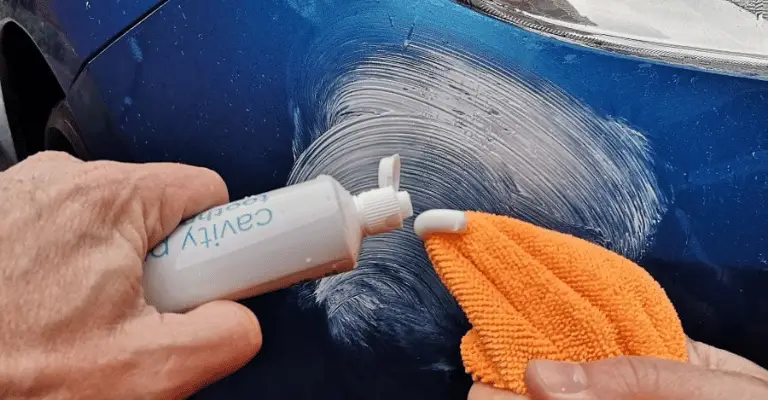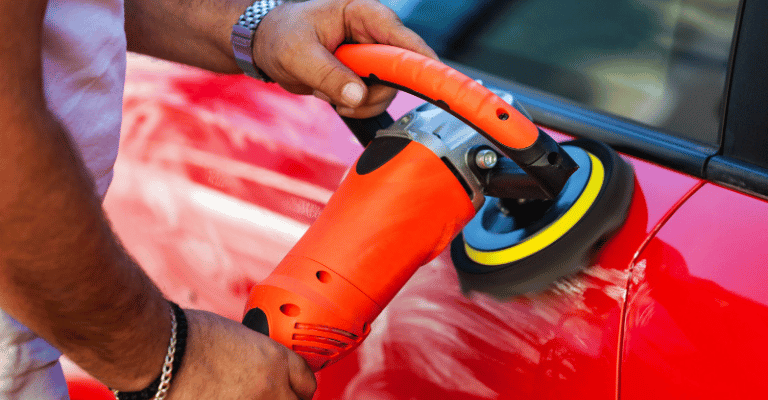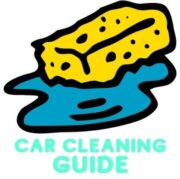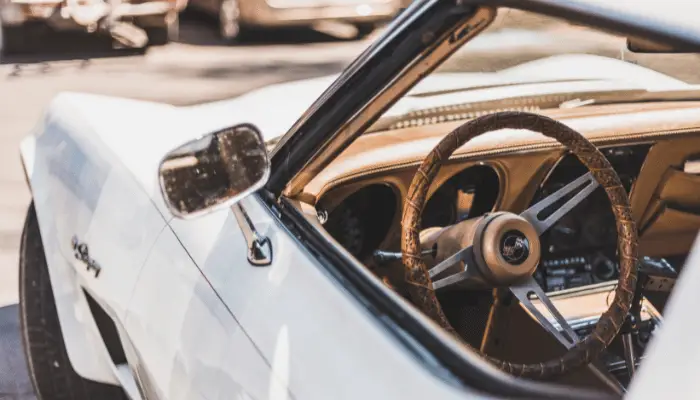Last Updated on November 8, 2023 by Chase Manhattan
Are those unsightly scratches on your black plastic trim driving you crazy? Does it feel like a blemish on your otherwise immaculate automobile? Fear no more! My step-by-step guide is here to introduce you to an easy, beginner-friendly method to remove those bothersome scratches.
Not only will it restore your black plastic trim to its original, sleek appearance, but it will also save you a trip to the repair shop, and a few bucks too. So, whether you’re a DIY enthusiast or a novice looking to pick up a new skill, this guide will take you through a simple process that promises excellent results.
Keep reading, and let’s dive in and transform those scratched surfaces into a thing of beauty!
- How to Clean Car Carpets Quick and Easy - July 10, 2024
- Can You Touch Up Clear Coat? Yes and No (Here’s Why) - November 25, 2023
- How To Wax A Car By Hand: A Comprehensive Guide - November 14, 2023
Quick Navigation
Understanding Car Exterior Materials: Focus on Black Plastic Trim
From the variety of materials used in constructing modern vehicles, it’s worth noting that the black plastic trim is one piece that often stands out. Despite being easy to scratch, this feature offers incredible benefits that simply cannot be overlooked.
One of the distinct advantages of using a black plastic surface in car manufacturing is its lightweight nature. This attribute doesn’t only contribute to the overall weight reduction of the vehicle but also enhances fuel efficiency, a key consideration in today’s eco-conscious world.
Additionally, due to its flexibility, plastic can easily be molded into various designs and shapes, allowing manufacturers to add unique aesthetic touches to their models. However, as durable as it may seem, black plastic trim isn’t impervious to damage. Scratches and other forms of wear can degrade its appearance over time, potentially diminishing your car’s visual appeal. Hence, protecting and maintaining this component becomes just as important as any other part of your vehicle’s exterior.
Despite these challenges, its versatility and functionality make black plastic trim an integral part of modern automotive design.
Read more: How to Remove Scratches from Black Plastic Bumpers
Common Causes for Scratches on Black Plastic Car Exterior Trim
Scratches on your car’s black plastic trim are a common occurrence, amongst the different types of car scratches, resulting from a variety of factors. While the results of a minor incident often go unnoticed, these seemingly insignificant events can lead to a considerable amount of damage.
An inadvertent touch against rough surfaces can leave marks that mar the pristine appearance of your precious vehicle. Likewise, accidents or vandalism can cause substantial harm that begs for immediate attention and repair.
Day-to-day chores such as washing your car or moving items around might seem harmless, but without proper caution, they can induce scratches and dents. The silent accumulation of debris and dust further exacerbates the deterioration process. These particles act as invisible assailants, slowly eating away at the surface integrity over time.
Moreover, the constant exposure to harsh elements like rain and sunlight can accelerate the degradation process. Rainwater carries corrosive substances which can gradually erode the finish, while the relentless UV radiation from sunlight can fade the color and cause cracks.

Step-by-Step Guide on How to Remove Scratches from Exterior Plastic Trim
Repairing scratches on your black plastic car exterior trim might seem like a daunting task, but with the right approach and tools, you can restore its original appearance. Here is an easy-to-follow guide on how to remove scratches from your car’s plastic trim:
Step 1: Cleaning the Scratched Area
Before you begin the repair process, it is crucial to clean the damaged area thoroughly. You can use a car wash shampoo or a mild dish soap mixed with warm water to remove any debris or contaminants that might interfere with the repair process. After cleaning, ensure the plastic surface is completely dry before proceeding to the next step.
Step 2: Assessing the Damage
The depth and severity of the scratch will determine the repair method. Shallow scratches can be treated with light abrasives such as toothpaste or baking soda, while deeper scratches may require more intensive techniques such as sanding.
Step 3: Buffing Out Light Scratches
For mild scratches, toothpaste or a baking soda paste can work as a mild abrasive. Apply the paste to the scratch and use a clean cloth to gently buff the area using circular motions. Rinse with water and repeat the process until the scratch is no longer visible. For more noticeable scratches, you may need to make the area malleable first. This can usually be accomplished with short bursts from a heat gun.
Step 4: Treating Deep Scratches
For more severe scratches, you may need to resort to wet sanding. Start with a coarse sandpaper, such as 800-grit, and gradually move to finer grits as the scratch starts to disappear. After the sanding process, clean the area again to remove any dust or debris.
Step 5: Polishing for a Perfect Finish
Once the scratch is removed, you might notice that the treated area lacks the shine of the rest of the plastic surface. To restore this, use a plastic polishing compound and apply it in circular motions with a clean, dry cloth. Repeat this process until the plastic surface regains its original shine.
Reference Video for Trim Restoration

Techniques to Buff Scratches out of Plastic
Buffing is a technique commonly used to remove scratches from plastic surfaces. It involves the use of a buffing compound, which is slightly abrasive, to gradually wear down the scratched area until it is level with the surrounding surface.
For plastic car trim, you can use common household items like toothpaste or baking soda, both of which contain mild abrasives. Apply the compound to the scratched area and buff it with a clean, soft cloth using circular motions. Repeat the process until the scratch disappears and the surface is smooth.
The Best Plastic Car Scratch Remover Products
Several scratch remover products available in the market are specifically designed for plastic car trim. Some of the top-rated ones include Mother’s California Gold and the Polyvance Plastic Cleaning Kit. These products not only effectively remove scratches but also condition your car’s trim, providing a shiny, like-new appearance.
[Here’s the Cost to Repair a Bumper]
DIY Methods for Removing Scratches from Black Plastic Trim
If you prefer a more hands-on approach, there are several DIY methods to remove scratches from your car’s trim. One popular method involves using toothpaste as a mild abrasive. Applying toothpaste to the scratched area and buffing it with a soft cloth can effectively remove minor scratches. For deeper scratches, a more intensive approach may be required, such as wet sanding with micro-grit sandpaper.
Tips for Preventing Scratches on Your Car’s Plastic Trim
Prevention is always better than cure. Here are a few tips to prevent these common scratches on your car’s trim pieces:
- Regular Cleaning: Regularly clean your car to remove dirt and debris that can cause scratches.
- Gentle Washing: Be gentle when washing your car. Avoid using harsh brushes or abrasive cleaning agents.
- Protective Products: Apply protective products specifically designed for car exteriors. These can provide a protective layer against scratches.
- Careful Handling: Be careful when loading and unloading items from your car to prevent accidental scratches.

Professional Services for Car Scratch Removal
While DIY methods can effectively handle minor scratches, severe scratches might require professional attention. Professional car detailing services have the tools, products, and expertise to effectively remove scratches and restore the original appearance of your car’s plastic surface. Here are some services that a professional may offer to remove these scratches:
Paintless Dent Repair (PDR)
This technique is most often used for minor dents and ding repairs. The process involves using specialized tools to massage the dented area from the inside out, restoring the metal to its original form without damaging the car’s paint job.
Scratch Repair and Touch-up Service
Professional services will often use color-matching technology to create the exact color of your vehicle. The scratch is then carefully sanded, primed, and painted to seamlessly blend with the rest of the car’s exterior.
Buffing and Polishing
Buffing and polishing are used for light scratches that haven’t penetrated the clear coat of the car’s paint. The process involves the gentle removal of a thin layer of clear coat, smoothing out the scratch and restoring the shine of the car. Typically, a soft microfiber cloth is used for this step.
Deep Scratch Repair
For deeper scratches that have penetrated the paint and primer, a more intensive repair process is required. This may involve sanding down the area, applying a body filler, re-priming, and then painting and clear-coating.
Nano Coating
Some professional services may offer nano coating as a preventive measure against future scratches. This clear, ceramic coating adds an extra layer of protection to your car’s exterior, making it more resistant to scratches, dirt, and water.
FAQs and Related Questions
What is the best method for removing scratches from black plastic trims?
Use a plastic polish designed for black plastic surfaces. Clean the trim with mild soap and water, then gently buff the car scratches in a circular motion until they fade or disappear.
Can I use household items to remove scratches from black plastic trims?
While some household items like toothpaste or baking soda may work for minor scratches, it’s better to use dedicated plastic polishes for more effective results.
Are there any preventive measures to avoid scratches on black plastic trims?
Yes, avoid abrasive brushes, park away from bushes and tree branches, and apply protective sealants or waxes for prevention. Regular cleaning and maintenance help too.


